“The real history of music is not respectable. Far from it. Neither is it boring. Breakthroughs almost always come from provocateurs and insurgents, and they don’t just change the songs we sing, but often shake up the foundation of society.”—Ted Gioia
During the 1960s folk music craze, I studied guitar in Cambridge with Jim Kweskin, leader of his own crackling, tightly woven Jim Kweskin Jug Band. This revival group consisted of a rackety collection of folk players that featured, among others, the bluesy vocals of Geoff Muldaur and Maria D’Amato (who would become Maria Muldaur), plus the in-the-pocket jug and washtub bass of Fritz Richmond. Geoff Muldaur’s washboard sounded like somebody shakin’ a box o’ bolts.
Among the “folkies,” the Kweskin band focused on something other than just coal miner strikes or English ballads to tear your heart out: they sat right down into the rhythm, the groove, the swing. They bought me my ticket into the jazz heartbeat.
Kweskin gave me tablature for his finger-style technique, and when I finally got it, I felt I had turned into some kind of god. It was all about swing rhythm, which embodies resonance. Ask anyone who has strutted in a New Orleans “Second Line.” In the moment of resolution, there’s no past or future—no “afterlife”—just what’s happening, now. As Daniel Levitin has written, “The thought of a musical concert in which a class of professionals performed for a quiet audience was virtually unknown through our species’ history.”
The Kweskin jug band was by no means the first, as he would no doubt confess. Jug bands themselves began around the turn of the last century, just as ragtime came on. They turned up in Louisville, Memphis, and other Southern towns, and they were an immediate hit—popular even among Louisville’s wealthy elite. They brought good-time music, music to raise the dead, to celebrate life—the seed of jazz. Bob Dylan coined the New Orleans pulse: “The past doesn’t pass away so quickly here. You could be dead for a long time.”
The bands brought a new instrument: the ceramic jug, played like a trombone or tuba, with practiced embouchure. Sam Charters writes, “The characteristic sound of the jug band was the sound of the jug, low and hoarse below the higher pitch the violin, the harmonica, or even the clarinet and saxophone…it was the sound of the jug that set the band apart.”
Jug bands had come from African and minstrel traditions, which included, as Michael L. Jones has noted in his excellent Louisville Jug Music, the “ingenuity to make something from nothing.” Jones recounts a WPA slave narrative about how bondsmen used animal remains to make music:
Dere wasn’t no musical instruments. Us take pieces of a sheep’s rib or cow’s jaw or a piece of iron, with a old kettle, or a hollow gourd and some horse hair to make the drum…Dey’d take de buffalo horn and scrape it out to make de flute. Dat sho’ be heard a long ways off. Then dey’d take a mule’s jaw-bone, and rattle de stick ‘cross its teeth.
A tourist recalled one plantation corn-shucking frolic: “The scraping of fiddles and the thumping of banjos having been heard above the clatter of spoons, soup-plates, and gourds,” percussion pieces all.
In his Creole Trombone, John McCusker recounts a post-slavery plantation memoir: “The boys sang and blew through the pipes with the drummer keeping time on the lard can and it was really remarkable the harmony they could get out of all that junk.”
This is not to mention the pervasive patting “Juba,” where, as Roger Abrahams has written, “through clapping hands, patting legs, arms, and armpits, snapping fingers, and other such rhythmic effects and countereffects, an individual could use his or her whole body to create multiple rhythms simultaneously.”
The practice emerges from African polyrhythm modality, which shows up in New Orleans’ polyphonic early jazz, “a street-corner conversation with everyone trying to get a word in edgewise,” as Bruce Boyd Raeburn has written. The idea lives on in New Orleans’ second-line tradition. Its stay-alive jive pervades all aspects of Black American roots music—minstrelsy, jug bands, blues, and jazz.
Louisville became fertile ground for the early jug bands, in part due to its location near the intersections of the Ohio, Tennessee and Mississippi Rivers. As time passed, New Orleans riverboat orchestras stopped in town, bringing horns, drums, string bass, and piano—the “Big Noise” of the Crescent City. Jones writes, “For this reason, Louisville jug music stands out as unique…usually classified as proto-jazz rather than folk or blues…. Louisville musicians absorbed jazz styles as they were being created.”
This raw, proto-jazz beat stood out in the bands run by the vocalist, comedian, and bandleader Earl McDonald, who founded the Louisville Jug Band in 1902. They made so much noise that they were asked to gig, the next year, at the Kentucky Derby. And according to Jones, they were the first jug band to record.
McDonald’s bands evolved into the Dixieland Jug Blowers, who set the tone for the genre. As opposed to the back-porch, ‘hillbilly” nature of many jug bands, their sound came on strong, tight, and swinging, underscored with McDonald’s barreling jug. As a teenager, McDonald had studied bass horn and string bass. As I like to say, “If the roots die, so does the tree.” In jazz, bass is the root, the “big stick.”
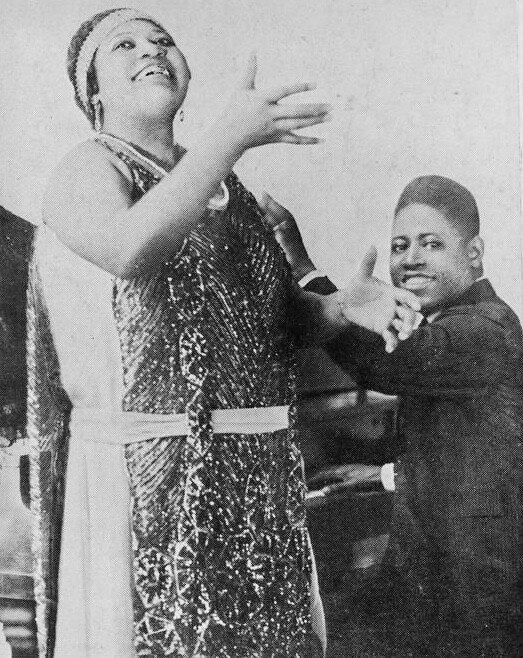
The higher harmonics of the DJB’s symphonic timbre came from the talents of Clifford Hayes on violin/alto sax and his nephew Cal Smith on tenor guitar/tenor banjo. In his popping, bending downstrokes, Smith’s playing recalls that of the great Teddy Bunn. As Jones recounts, another McDonald colleague recalled that “every black band—Count Basie, Duke Ellington, Jimmy Lunceford, even Benny Goodman’s people—whenever they were in Louisville they were all looking for Cal. They all wanted to go hear him play.”
It didn’t stop there. McDonald’s bands pulled top sidemen, including Earl Hines on piano and Johnny Dodds on clarinet. Dodds, just two years out of King Oliver’s Creole Jazz Band, sounded like someone had let the horse out of the barn. In New Orleans, Clarence Williams had coalesced his own Seven Gallon Jug Band, featuring the Harlem stride tickler Willie “The Lion” Smith—a nice Jewish boy!
In Chicago, the “Mother of the Blues” Ma Rainey began recording in 1923, jumping on a trend that began with Mamie Smith and the Great Migration. Rainey later assembled her Tub-Jug Washboard Band, which sported a “talking” kazoo—just as Jim Kweskin would do half a century later.
Coming into the present, the top resurgence band Tuba Skinny has included in its book “Sweet Lovin’ Old Soul,” from the early vaudeville vocalist Sara Martin (known as the “Black Sophie Tucker”). Martin, who came up in Louisville, knew and recorded with McDonald and Hayes. She cut the tune around 1924 as “I’m Gonna Be a Lovin’ Old Soul,” billed as “Sara Martin Jug Band” with Clarence Williams. The year before, she had sung with W.C. Handy’s inchoate blues/jazz band, which had begun to push the beat. (As the great Jon Hendricks wrote on “Cottontail,” “I split from there without a second to spare, I could hear the bullets flying through the air.”)
I heard Tuba Skinny perform “Sweet Lovin’ Old Soul” at 2013 French Quarter Festival, with Erica Lewis on serious vocals, “rocking hard in the still centre of the beat,” to use Geoff Dyer’s elegant phrase. The band’s summoning, hornful-of-blues sound pushed Lewis inevitably along.
Thus has surfaced the river-esque link between jug band music and the jazz roots.
The First Annual Great Northeast Jug Band Festival
Jug bands are still in town today, bringing the clattering, squealing chassis of the jazz drive. October first of this year brought the First Annual Great Northeast Jug Band Festival to Arlington, MA, just a few miles from my Newton home. My musical all-things-strings friend, Tom, alerted me. It was free, and we jumped on it. The big, window-encased room allowed plenty of afternoon light into the Arlington Community Center, which hosted four bands for a full house.
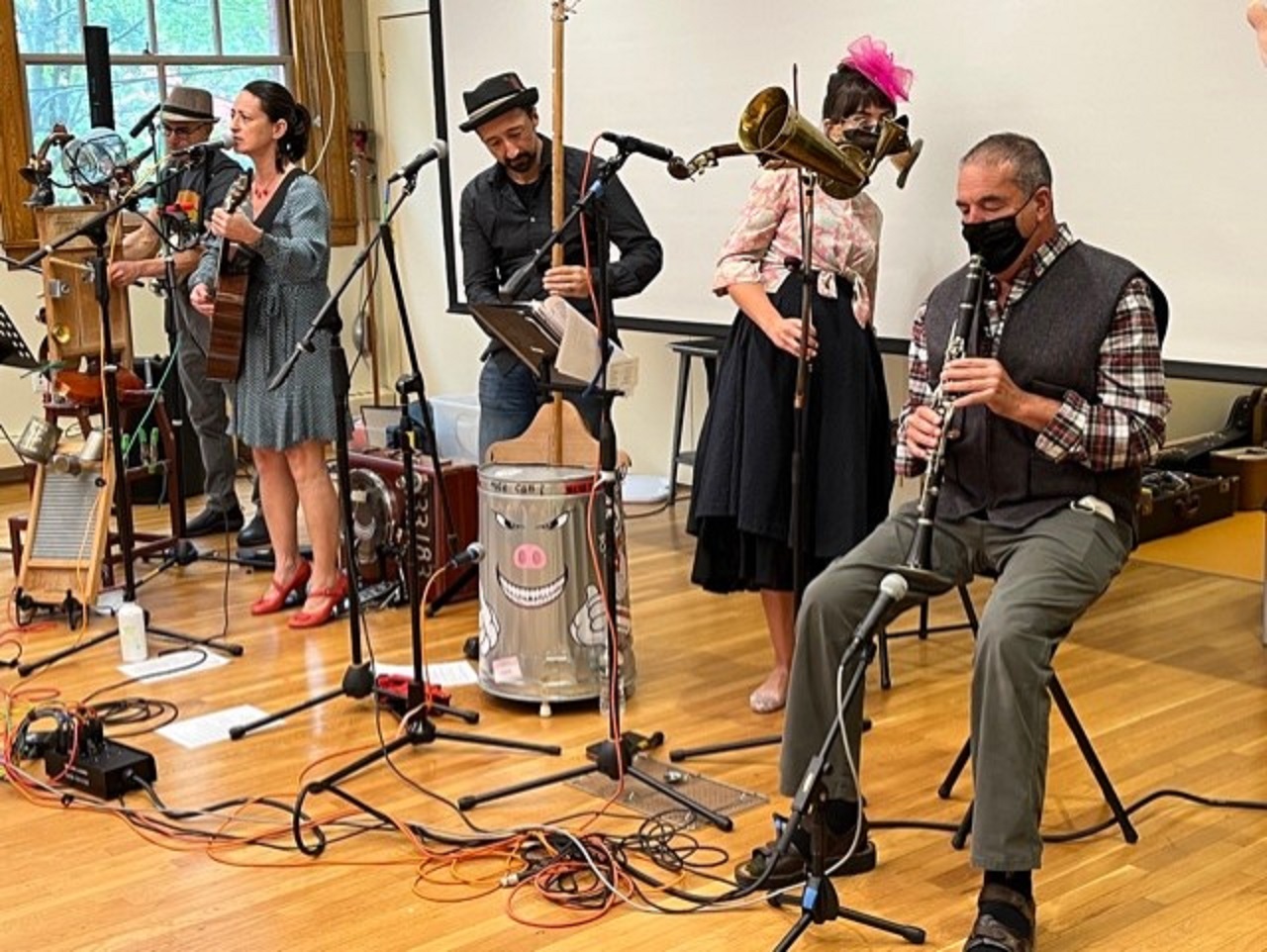
The Squeakeasy Jug Band brought a four-human aggregation of home-drawn musicians playing back-porch music with banjo, washboard, guitar, stroh violin, washtub bass, clarinet, kazoo, and various alien instruments. True to form, they had a democratic, “who cares?” sound where everyone had a chance to play. Good choice of classic jug band and early jazz tunes, including “Beedle Um Bum,” “Sadie Green,” Fats Waller’s “Your Feet Too Big,” plus their own “Leaf Blower Blues.” The Chick Webb tune “When I Get Low, I Get High” saw the two Squeakeasy women smiling harmony to each other. On the Armstrong/Fitzgerald tune, “Who Walks In When I Walk Out,” one of the women, Jasmine Moran, sang a wheedling, yelping vocal as she played rock-bottom washtub bass.
The High Maintenance Jug Band, another “back porch” “aggregation,” consisted of two gentlemen (they probably don’t use that word with each other), wrangling old material from sources like Peetie Wheatstraw, Blind Blake, and Leroy Carr/Scrapper Blackwell. Their sound bordered on country.
The duo’s guitar player sported a rattle on his tapping shoe. On Carr’s “How Long Blues,” the pair brought a ground-floor 7th chord into their rhythm, creating forward tension and leaning the tune low. Their CD, High Maintenance Jug Band, includes a heartfelt lament, “Shine on Moon,” adding a female voice to create mellifluous harmony.
Most of their material came from the Memphis Jug Band, including “Got a Letter from My Darlin’,” “On the Road Again,” and “She Done Sold It Out,” a jug band standard. The iconic Memphis Jug Band, assembled a generation after the first Louisville groups, offered harmonica/kazoo-based raunchy blues, often featuring the pounding jug of Jab Jones. The band has become a model for many of the latter-day jug bands. People like Jerry Garcia & David Grisman, as well as Dave Van Ronk, have covered their tunes. Blues music can expand the playable borders.
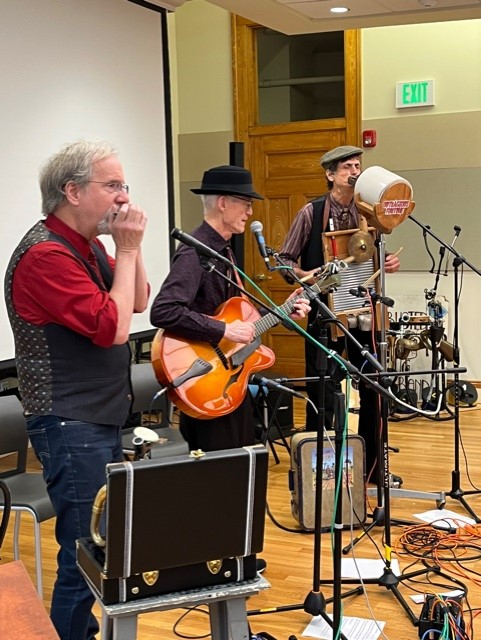
Outrageous Fortune was a tighter, “cleaner” band than the first two—and intendedly so. Around since 1998, they had clearly worked their 3-man arrangements. Their leader, Chris Welles, plays a well-studied guitar from the ragtime/blues/jazz tradition. He’s also a trained vocalist who, with his two mates, turns out harmonies sounding like breeze through the trees.
Their “Wild About My Lovin’,” covered from a 1929 track by the Mississippi-born Jim Jackson, opened with Welles’ guitar riff under his vocal verse, bringing on a 3-man churchlike harmony. Underneath came Rod Thomas’ talking-to-himself, jews-harp harmonica and Dan Dick’s jug, resounding like a tuba inside a barrel. (Dan also plays bass, washboard, banjo, and mandolin.)
The band continued their groove on Irving Berlin’s “Walking Stick,” written in the heat of the Swing Era when everybody danced. The tune had been covered by Leon Redbone and by Louis Armstrong & the Mills Brothers. Outrageous Fortune’s “going nowhere” tempo fit right in the footfall of swing rhythm. Dan Dick’s jug played a solid two-beat time, and his kazoo-trumpet said something important (but not impotent.)
“We’ve never written down our harmonies. We just work them out and memorize them,” Welles told me. This recalls the old proto doo-wop, group-improv routine of “cracking up a chord,” practiced widely by early Negro singing quartets. In his “Play that Barbershop Chord: A Case for the African American Origin of Barbershop Harmony,” (American Music, Fall 1992) Lynn Abbot writes the practice “was born in the unabashed celebrations of the ‘weird,’ organically blended harmonies that first distinguished the group singing traditions of plantation slavery.” The bondsmen made it up, right out of the box.
Welles often plays finger-style (Piedmont) guitar—the style Kweskin taught me, that he found in the music of Blind Blake, Mississippi John Hurt, and others. Welles told me, “If you play finger-style guitar, in a way you’re trying to be a piano player. Some guitar arrangements have tenths going on—very much like a Jelly Roll Morton piece, adapted for guitar.” The broad, left-hand tenth intervals became standard for Harlem stride pianists James P. Johnson, Fats Waller, and others.
Finally, Jonah and the Whale, adapted from the country musician Buddy Greene (and perhaps others), emerged as a showcase for Rod Thomas’ tremulating bass voice and the American gospel tradition. It became a call-and-response between Thomas’s vocal and mouth harp, echoing (ironically, for a sea song) train travel, wind blowing past the engine. Dan Dick decorated the sound with his fully equipped washboard-cymbal-woodblock-whistle-cowbell ensemble.
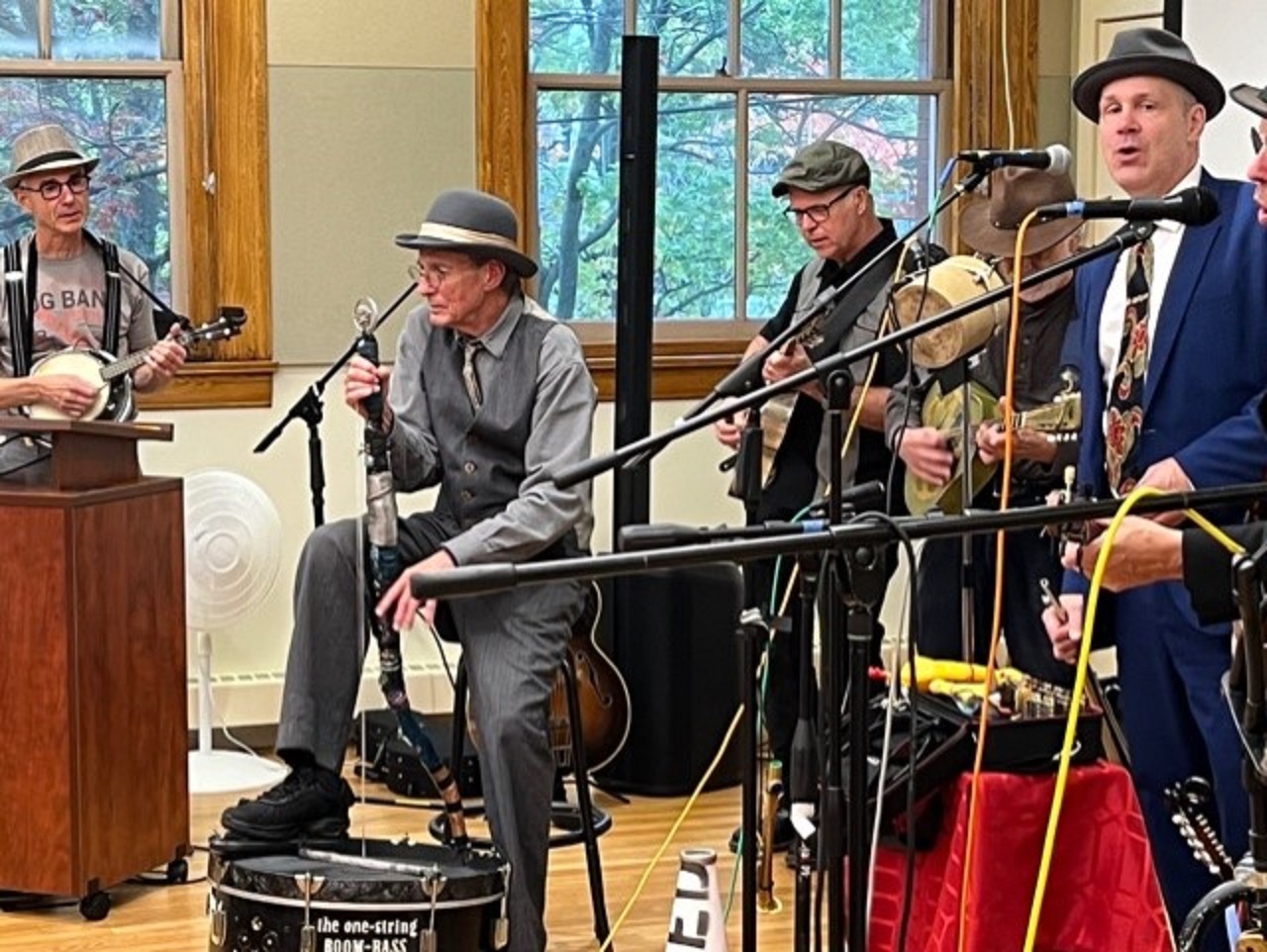
After I heard (online) the Busted Jug Band’s “When the Sun Goes Down in Harlem,” I knew I had to make this festival. In person, the band came on like a symphony of disaster, rocking like a Mississippi riverboat. Yet they had pulled this tune from the book of the Harlem Hamfats, a 1930s small-group-swing Chicago studio band, whose vocal material could echo that of Louis Jordan or Cab Calloway.
In person, “When the Sun” opened with well-rounded kazoo antiphony—section playing! On the opening lyric, “When the sun goes down in Harlem, you can hear them women holler,” a kazoo screamed and the whole band bellowed—like Black church heterophony. Things seemed to happen when they were supposed to happen, but no one had planned it.
Alan Lomax has described Africanized hymn singing in words that seem to apply here:
There emerged a remarkable kind of harmony, in which every singer was performing variations on the melody at his or her pitch, yet all these ornaments contributed to a polyphony of many ever-changing strands–surging altogether like seaweed swinging with the waves….
When the kazoos came in together for the out-chorus, the group cast their fate to the tsunami. More than homespun instruments, this band improvised an entire sound. As the composer and author W.A. Mathieu once told me, in jazz, “Everybody is playing a different song, but everybody is playing the same song.” Democracy in action.
Early jazz music broke nationally when, in 1914, the Original Creole Band out of New Orleans embarked on what would become a four-year vaudeville tour covering multiple states.
A report from the Los Angeles Record described their sound:
In a corner of the café a strange orchestra was producing melody which would have caused an Apache redskin to emit a blood-curdling yell and go on the warpath….The cornetist blew uncanny sounds from his horn, interspersing through the music imitations of yelping dogs, crowing roosters, locomotive whistles and terrible groans.
Sure enough, a short 110 years later, the Busted Jug Band laid down their “Count Your Chickens Before They Hatch,” where, to a march-time backbeat, they broke out more barnyard bedlam, squeezing squeaky rubber fowl like a wolf invading a hen house. But somehow—it was music! Jug band music.
On “4th Street Mess Around,” reminiscent in theme of Creedence Clearwater’s “Down on the Corner,” Busted came in booming with a two-beat, street-scene groove. The band’s washtub bass, mandolin, banjo/uke, squeeze box, kazoo, slide whistle, and resonator guitar seemed to bring the sounds of a whole city. “Makes no difference where you were born,” go the lyrics, “the jug band’s got your water on.”
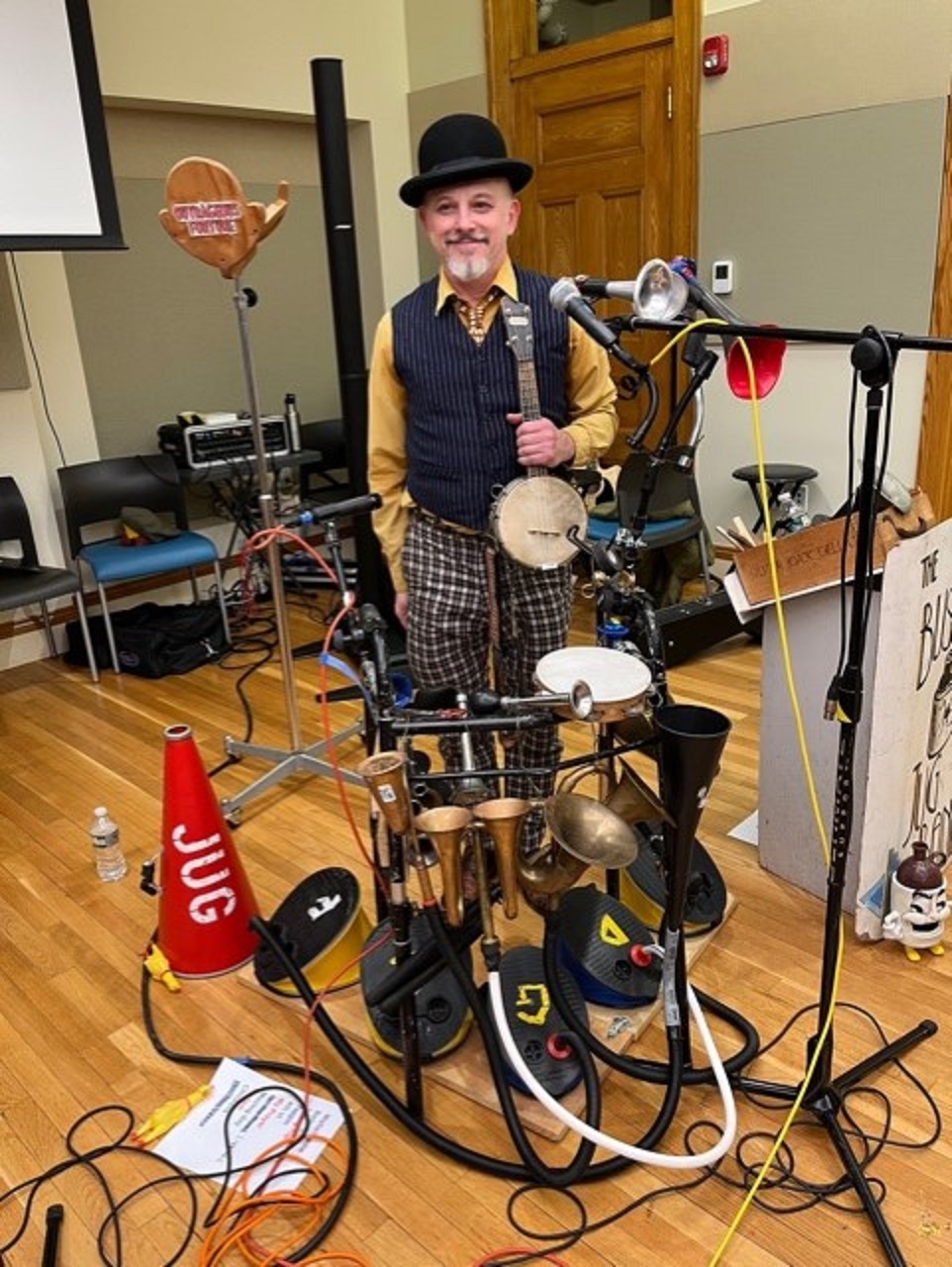
According to one of its founders, Jeremy Lyons, Busted uncovered part of its direction from Spike Jones’ City Slickers, and part from the Hoosier Hotshots, a 1930s Indiana hokum group featuring novelty vocals plus clarinet duets with slide whistle or bicycle horn. The Hotshots played with the Three Stooges and appeared on the National Barn Dance radio show. “I like the showmanship in jug band music,” says Lyons, who has played on New Orleans streets with the Big Mess Blues Band. “It is real entertainment music—no pretension that it is serious.”
“I don’t read music and I haven’t ever done real jazz,” he confesses. “But traditional New Orleans style is similar to a lot of what we do. It is what I aspire to.”
Jug bands carry a sound that began in the plantation, church, and blues traditions and helped create America’s vernacular culture. “4th Street Mess Around” comes from the Memphis Jug Band, launched around 1927 by the Beale Street guitar/harmonica player Will Shade. Their territory included “street corners, juke joints, city nightclubs, political rallies, private parties, hotel ballrooms, medicine shows and riverboats,” notes The Corner Jug Store. Like the early New Orleans bands, MJB had to cut many styles and repertoires to suit its many-colored audiences.
Their venues naturally brought the dance crowd, suggested in a 4th street lyric:
Go down Fourth until you get to Vance,
Ask anybody about that brand new dance
The gals will say, “You’re going my way,
it’s right here for you, here’s your only chance.”
That “brand new dance” swaggered into turn-of-century American cities, in forms such as the Eagle rock, turkey trot, fox trot, camel walk, and Castle walk, then the Charleston and the Lindy Hop—the latter very much in play today. It brought together diverse social groups and watered the soil of democracy. And like orgasm, it could also bring freedom in the release-from-gravity swing. No wonder it keeps coming back—as seen now in the international upsurge in swing dance (even in Ukraine!)
I suppose it all could be tied back to New Orleans brass band marches. As the drummer Baby Dodds recalled, “It’s the stride…that puts you in the right beat. It’s all taken from the snare drum, which keeps everybody in time….If you are out of step when you hit your stride, you can’t half play.” (Daniels/Young: 24)
After I moved on from the jug band scene, I tried to go modern. I listened to Monk, Miles, Bird, Wes, Grant Green, Django—even Albert Ayler. I studied guitar with top-flight players, trying to ascend into the jazz stratosphere. I continue to savor all of this for its blues feeling, depth, and intricacy. To this day, I see all jazz as the same river, long as it swings.
But the locomoting street-band groove of Louisville, Memphis, and New Orleans made a final claim on me. One way or another, all the stratospheric harmonics trembled in the growl of a ceramic jug played with a good lip. “Jug band music,” reminisced the Memphis Jug Band in their “Jug Band Quartette,” “cert’nly was a treat to me.”
Peter Gerler has written about jazz since the early 1990s. He has been published in American Legacy, DownBeat, JazzTimes, Humanities, The Boston Globe, New Orleans Gambit, Moultrie Observer, WBGO, Upbeat, www.jazz.com, www.nejazz.com, and other venues. He has presented on early jazz at Satchmo Summerfest, River Road African American Museum, Classic Jazz at Lincoln Library, Cambridge Center for Adult Education, Newton Lifetime Learning, and numerous senior facilities in the Boston area. Visit him online at www.jazztalks.com.























